Yuri Schmid
In view of the current pandemic, I wondered whether a global plant pandemic was also possible. Have we already experienced such a pandemic, are we prepared for it in the same way as we were for COVID-19? Because humans are not the only carriers of disease. To answer this question, I looked into the status, opportunities and deficits of integrated pest management (IPM) and read up on a completely new topic for me.
How quickly do viruses and bacteria, which plants infect, spread on a global level?
Is the wind sufficient as a spacious vector to transport enough large quantities of pathogens far enough?
How can monocultures protect themselves if they themselves have almost no natural flora and hardly differ from one another?
Why is a plant often no longer healthy, is it infected once?
What’s the problem?
A large proportion of cereal varieties today are made up of genetically nearly identical individuals. Low diversity in terms of height, germination, development time, seed set and protein content simplifies management and maximizes yields. However, the susceptibility of a crop to disease increases considerably, and entire grain fields can be decimated within a very short time.
Monotypic crop fields not only mean low intraspecific genotypic diversity, but also lead directly to lower variability of different plant species. This is also associated with natural microflora. The natural microflora cannot help the plant to protect itself from pathogens. And once a plant is sick, it is often so until the end of its life. So the problem goes beyond the fact that just one corn plant is no different from the next.
This minimal resistance leads to increased use of insecticides, which in turn has a negative impact on the environment. Although they protect against pathogens, they also make it impossible for a natural flora to establish itself on the plant to protect it from enemies. The use of pesticides, in turn, leads to increased resistance. This can be particularly dangerous if these resistances occur in vectors that are also suitable for humans, such as mosquitoes.
Further, increasing plant species diversity often leads to additional logistical costs and is therefore only worthwhile to a limited extent from an economic perspective. Modern, automated agricultural machinery cannot process more than one crop per field, and ecological compensation areas are often associated with a loss of arable land, which is no longer available for production. So it will hardly be the big agronomists who are researching improvements in this direction. (Tooker & Frank, 2012)
Different vectors can serve as carriers of bacteria, viruses and fungi. Disease outbreaks correlate with rainfall, since a raindrop, after hitting a leaf, is hurled away by the leaf like a springboard and thus spreads rapidly (Garcia & Topinka, 2018).
In the same way, wind can carry away the pathogens on seeds or pollen. This can happen over long distances and even across continents. One consequence of this is that spores can be transported to regions where host plants are seasonally unable to grow, giving the pathogen a decisive advantage in growth (Tooker & Frank, 2012). Such an invasion via the air often occurs over a large area and at one blow (Brown & Hovmøller, 2002).
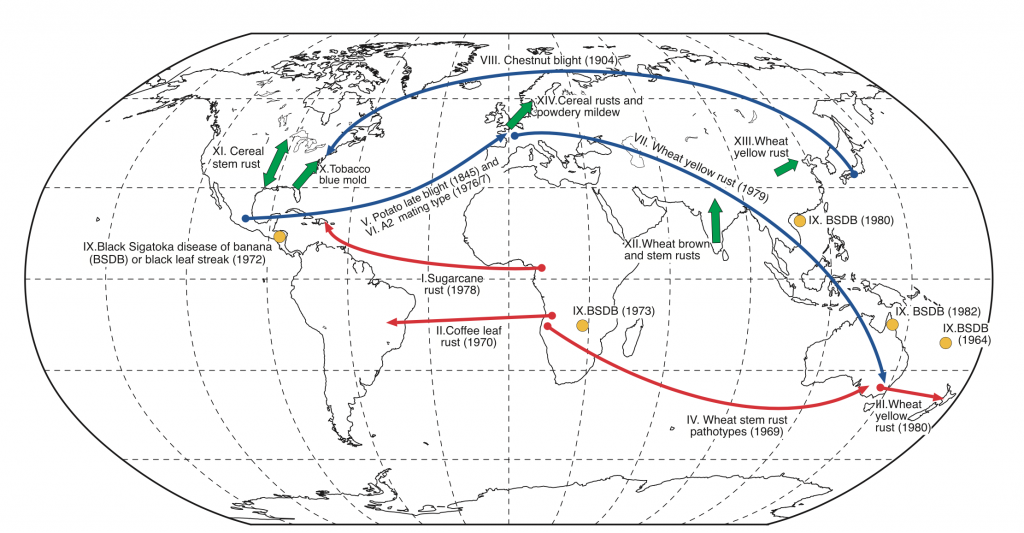
Figure 53.1 – Selected dispersal events of fungal pathogens (Brown & Hovmøller, 2002).
Global trade is, however, not unlike in humans, mainly responsible for the intercontinental spread of diseases. We experience a plant pandemic about every two to three years (B. McDonald, 2020), as global agriculture focuses on only a few plants among the thousands of species that exist. As plants have been redistributed from their centers of origin, fungi have followed, resulting in devastating outbreaks of such diseases (Brown & Hovmøller, 2002).
It is therefore noticeable that globalisation, the increasing world population and climate change (this is still very uncertain and must be researched) also exert great pressure on the occurrence and spread of pathogens in plants.
Possible Solutions
The idea that increased diversity within a species should be achieved is becoming more and more popular, which also makes absolute sense from an evolutionary point of view. Phemomana, such as bottlenecks and inbreeding depression can be avoided. A more diverse system not only shows a higher resilience but also a higher productivity. For example, colonies of honey bees from different queens have a much higher production rate than those from only one queen. Polycultures, i.e. a mix of different species, make it more difficult for pathogens to find and colonize the desired host plant. A greater species diversity creates the right microclimate to positively influence natural enemy fitness, abundance, diversity. (Tooker & Frank, 2012)
In order to summarize a sustainable solution strategy, I would like to citate McDonald and Stukenbrock (2016):
«The long-term solution will be to change the overall structure of agro-ecosystems to make them more heterogeneous, both environmentally and genetically, over both time and space, in order to impose trade-offs on the corresponding pathogen populations [68]. An over-riding principle is the need to increase agro-ecosystem diversity in a dynamic way that fluc- tuates regularly (e.g. annually or every few years) in order to impose disruptive selection on populations of crop pathogens and force them to make trade-offs among traits. This ‘dynamic diversity’ can be implemented in many ways [67– 70], including improved deployment strategies for resistance genes and resistant cultivars, more frequent turnover of crop varieties that carry different resistance genes, improved deployment strategies for fungicides, more frequent crop rotations that include more species, smaller fields planted to individual crops and growing greater numbers of crop species per unit area under cultivation. The overall objective is to break up the adaptive landscape into smaller units that change on a regular basis to present the corresponding populations of crop pathogens with evolutionary dilemmas that lead to disruptive selection.»
How does Integrated Pest Management contribute to the Social Development Goals (SDGs)?
I see positive effects of sustainable IPM on SDG 1, 2, 3, 6 and 15.
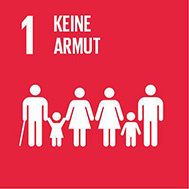 1.) In developing countries in particular, agriculture is the livelihood of a large part of the population. When a new fungal disease from South America reached Bangladesh in February 2016, approximately 16% of wheat crops were affected. For individual farmers, however, this meant a 100% loss of harvest, as the fields had to be completely burned down by order of the Ministry of Agriculture to combat the disease (Islam et al., 2016).
1.) In developing countries in particular, agriculture is the livelihood of a large part of the population. When a new fungal disease from South America reached Bangladesh in February 2016, approximately 16% of wheat crops were affected. For individual farmers, however, this meant a 100% loss of harvest, as the fields had to be completely burned down by order of the Ministry of Agriculture to combat the disease (Islam et al., 2016).
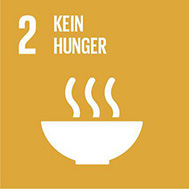 2.) The example from point 1 can also serve as an example if the second SDG is to be achieved, which aims to ensure food security and stands for “no hunger”. A sustainable agriculture is also one that allows diversity and biodiversity to exist. This makes it resistant to external stressors and undesirable evolutionary effects (e.g. bottleneck) can be avoided. The increased resilience can reduce the use of insecticides, which has positive effects on the environment, for example on groundwater quality. Genetically more diverse crops also show higher productivity and the use of fertilizers can also be reduced.
2.) The example from point 1 can also serve as an example if the second SDG is to be achieved, which aims to ensure food security and stands for “no hunger”. A sustainable agriculture is also one that allows diversity and biodiversity to exist. This makes it resistant to external stressors and undesirable evolutionary effects (e.g. bottleneck) can be avoided. The increased resilience can reduce the use of insecticides, which has positive effects on the environment, for example on groundwater quality. Genetically more diverse crops also show higher productivity and the use of fertilizers can also be reduced.
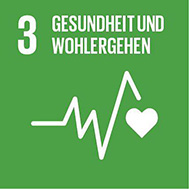 3.) Diseases due to water and soil pollution can be reduced by reducing the use of pesticides. Furthermore, a more conscious use of pesticides leads to a lower development of resistance to them. Diseases can also be transmitted to humans via certain vectors (for example mosquitoes).
3.) Diseases due to water and soil pollution can be reduced by reducing the use of pesticides. Furthermore, a more conscious use of pesticides leads to a lower development of resistance to them. Diseases can also be transmitted to humans via certain vectors (for example mosquitoes).
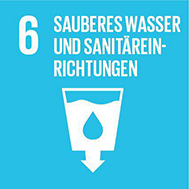 6.) Point 3 is directly related to SDG 6, which aims to provide clean drinking water for all. The resource water is a decisive factor for all aspects of social, economic and ecological development. I say that more diversity leads to less evaporation, which in turn allows better use of irrigation.
6.) Point 3 is directly related to SDG 6, which aims to provide clean drinking water for all. The resource water is a decisive factor for all aspects of social, economic and ecological development. I say that more diversity leads to less evaporation, which in turn allows better use of irrigation.
 15.) SDG 15 defines goals to “integrate ecosystem and biodiversity values into national and local planning, development processes, poverty reduction strategies and accounting systems, […] raise and significantly increase financial resources from all sources for the conservation and sustainable use of biodiversity and ecosystems, […] take immediate and significant action, to reduce the degradation of natural habitats, halt the loss of biodiversity and protect and prevent the extinction of endangered species by 2020 [and] promote the fair and equitable sharing of benefits arising from the use of genetic resources and equitable access to them, as agreed at international level. »
15.) SDG 15 defines goals to “integrate ecosystem and biodiversity values into national and local planning, development processes, poverty reduction strategies and accounting systems, […] raise and significantly increase financial resources from all sources for the conservation and sustainable use of biodiversity and ecosystems, […] take immediate and significant action, to reduce the degradation of natural habitats, halt the loss of biodiversity and protect and prevent the extinction of endangered species by 2020 [and] promote the fair and equitable sharing of benefits arising from the use of genetic resources and equitable access to them, as agreed at international level. »
(EDA, 2020)
Conclusion
Although it is not really surprising that plants also regularly fall ill over large areas, I was amazed at the frequency and extent of such events. I am amazed at how great the chances of greater genetic diversity can be, both ecologically and economically. There are many social factors related to the food system that can be improved by a successful IPM.
References
Brown, J. K. M., & Hovmøller, M. S. (2002). Aerial Dispersal of Pathogens on the Global and Continental Scales and Its Impact on Plant Disease. Science, 297, 537-541.
EDA. (2020). Agenda 2030.
Garcia, X., & Topinka, B. (2018). How Do Infections Spread In Plants? Retrieved from https://www.sciencefriday.com/educational-resources/how-do-diseases-spread-between-plants/
Islam, M. T. (2016). Emergence of wheat blast in Bangladesh was caused by a South American lineage of Magnaporthe oryzae. BMC Biology.
McDonald, B. (2020).
McDonald, B. A., & Stukenbrock, E. H. (2016). Rapid emergence of pathogens in agro-ecosystems: global threats to agricultural sustainability and food security. rstb.royalsocietypublishing.org.
Tooker, J. F., & Frank, S. D. (2012). Genotypically diverse cultivar mixtures for insect pest management and increased crop yields. Journal of Applied Ecology, 49, 974–985.
Translator used:
www.DeepL.com/Translator (free version)
Media Attributions
- Selected dispersal events of fungal pathogens
- original-2
- original-3
- original-4
- original-5
- original